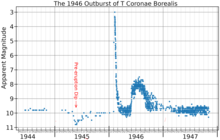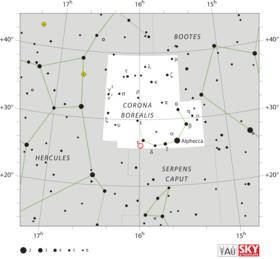北冕座T
| 观测资料 历元 J2000 | |
|---|---|
| 星座 | 北冕座 |
| 星官 | |
| 赤经 | 15h 59m 30.1622s[1] |
| 赤纬 | 25° 55′ 12.613″[1] |
| 视星等(V) | 2.0–10.8[2] |
| 特性 | |
| 演化阶段 | 红巨星 + 白矮星 |
| 光谱分类 | M3III+p[3] |
| 变星类型 | 再发新星[2] |
| 天体测定 | |
| 径向速度 (Rv) | −27.79[4] km/s |
| 自行 (μ) | 赤经:−4.220[5] mas/yr 赤纬:12.364[5] mas/yr |
| 视差 (π) | 1.2127 ± 0.0488[5] mas |
| 距离 | 806+34 −30[6] pc |
| 轨道 | |
| 绕行周期 (P) | 227.8 d[7] |
| 半长轴 (a) | 0.54 AU[6] |
| 偏心率 (e) | 0.0[7] |
| 倾斜角 (i) | 67[8]° |
| 详细资料 | |
| 红巨星 | |
| 质量 | 1.12[6] M☉ |
| 半径 | 75[8] R☉ |
| 表面重力 (log g) | 2.0[9] |
| 亮度 | 655[10] L☉ |
| 温度 | 3,600[9] K |
| 白矮星 | |
| 质量 | 1.37[6] M☉ |
| 亮度 | ~100[8] L☉ |
| 其他命名 | |
| 参考数据库 | |
| SIMBAD | 资料 |
北冕座T(T Coronae Borealis,缩写T CrB)是位于星座北冕座的一颗再发新星[11]。它最早是由约翰·伯明翰 (天文学家)在1866年爆发时发现的[12],然而它早些时候被观测到是一颗10等星[13]。它可能在1217年和1787年被观测到[14][15]。
描述
[编辑]
北冕座T的星等通常约为10等,接近典型双筒望远镜的极限。 之前曾观察过它两次爆发,分别在1866年5月12日和1946年2月9日,视星等分别达到2.0等和3.0等[16]。然而,最近的一篇论文显示,1866年的爆发可能具有2.5等的峰值范围,± 0.5[17]。即使在2.5等的峰值星等下,这颗再发新星也比夜空中大约120颗恒星还要暗[18]。它有时被昵称为“烈焰之星”[19]。
北冕座T是一个 联星系统,包含一颗巨大的低温恒星和一颗致密的高温恒星。主星是一颗表面温度较低的红巨星,它正在将物质转移到炙热的伴星上。炽热的伴星全部隐藏在来自红巨星的密集物质云中,是一颗被吸积盘环绕的白矮星。当系统处于宁静状态时,红巨星主导可见光的输出,系统呈现的恒星光谱为M3的巨星。炽热的伴星会贡献一些发射并主导紫外线的输出。在爆发过程中,白矮星因为热失控释放出大量的能量,系统的光度因而暴增[6][8][20] [21]。

该系统的两颗恒星每228天相互绕行一次。轨道几乎是圆形的,倾斜角度为67°[6]。
2016年迄当前的活动
[编辑]2016年4月20日,天空与望远镜杂志的网站报导,自2015年2月以来,它的亮度从10.5等持续变亮到约9.2等。1938 年,也有类似事件的报导,然后在1946年发生了爆发[22]。到2018年6月,这颗恒星略微变暗,但仍保持着异常高的活动水准。到2023年中期,它的亮度下降了0.35等;这是自2016年以来的最低亮度[23]。1946年爆发前的一年也发生了类似的变暗[24],表明可能在2024年9月之前爆发[25]。尽管据信它即将到来,但截至2024年10月,尚未观测到这样的新星[26]。
对下一次新星爆发的预测:
- 2026-2027(由N.F.H.Knight或W.M.Lindley在1946年所做的预测)[27]。
- 2024年2月中旬至2026年9月底(2023年3月做出的预测)[28]。
- 2024年1月至2024年8月中旬(2023年6月做出的预测)[29]。
- 2024年一月(2023年8月做出的预测)[30]
- 2024年10月底(2024年6月做出的预测)[31]。
- 2025年3月27日左右、2025年11月10日、2026年6月25日或2027年2月8日(2024年10月做出的预测)[32]。
参考资料
[编辑]- ^ 1.0 1.1 Gaia Collaboration; et al. Gaia Data Release 1. Summary of the astrometric, photometric, and survey properties. Astronomy & Astrophysics. November 2016, 595: 23. Bibcode:2016A&A...595A...2G. S2CID 1828208. arXiv:1609.04172
 . doi:10.1051/0004-6361/201629512. A2.
. doi:10.1051/0004-6361/201629512. A2.
- ^ 2.0 2.1 Samus, N. N.; Durlevich, O. V.; et al. VizieR Online Data Catalog: General Catalogue of Variable Stars (Samus+ 2007-2013). VizieR On-line Data Catalog: B/GCVS. Originally Published in: 2009yCat....102025S. 2009, 1. Bibcode:2009yCat....102025S.
- ^ Pourbaix, D.; Tokovinin, A. A.; Batten, A. H.; Fekel, F. C.; Hartkopf, W. I.; Levato, H.; Morrell, N. I.; Torres, G.; Udry, S. SB9: The ninth catalogue of spectroscopic binary orbits. Astronomy and Astrophysics. 2004, 424 (2): 727–732. Bibcode:2004A&A...424..727P. S2CID 119387088. arXiv:astro-ph/0406573
 . doi:10.1051/0004-6361:20041213.
. doi:10.1051/0004-6361:20041213.
- ^ 5.0 5.1 5.2 Brown, A. G. A.; Vallenari, A.; Prusti, T.; de Bruijne, J. H. J.; et al. Gaia Data Release 2. Summary of the contents and survey properties. Astronomy & Astrophysics. 2018. Bibcode:2018A&A...616A...1G. arXiv:1804.09365
 . doi:10.1051/0004-6361/201833051. VizieR中此天体在盖亚望远镜第二批数据发布的记录
. doi:10.1051/0004-6361/201833051. VizieR中此天体在盖亚望远镜第二批数据发布的记录
- ^ 6.0 6.1 6.2 6.3 6.4 6.5 Linford, Justin D.; Chomiuk, Laura; Sokoloski, Jennifer L.; Weston, Jennifer H. S.; Van Der Horst, Alexander J.; Mukai, Koji; Barrett, Paul; Mioduszewski, Amy J.; Rupen, Michael. T CRB: Radio Observations during the 2016-2017 "Super-active" State. The Astrophysical Journal. 2019, 884 (1): 8. Bibcode:2019ApJ...884....8L. S2CID 203593955. arXiv:1909.13858
 . doi:10.3847/1538-4357/ab3c62
. doi:10.3847/1538-4357/ab3c62  .
.
- ^ 7.0 7.1 Fekel, Francis C.; Joyce, Richard R.; Hinkle, Kenneth H.; Skrutskie, Michael F. Infrared Spectroscopy of Symbiotic Stars. I. Orbits for Well-Known S-Type Systems. The Astronomical Journal. 2000, 119 (3): 1375. Bibcode:2000AJ....119.1375F. doi:10.1086/301260
 .
.
- ^ 8.0 8.1 8.2 8.3 Stanishev, V.; Zamanov, R.; Tomov, N.; Marziani, P. Hα variability of the recurrent nova T Coronae Borealis. Astronomy and Astrophysics. 2004, 415 (2): 609–616. Bibcode:2004A&A...415..609S. S2CID 3000175. arXiv:astro-ph/0311309
 . doi:10.1051/0004-6361:20034623.
. doi:10.1051/0004-6361:20034623.
- ^ 9.0 9.1 Wallerstein, George; Harrison, Tanya; Munari, Ulisse; Vanture, Andrew. The Metallicity and Lithium Abundances of the Recurring Novae T CrB and RS Oph. Publications of the Astronomical Society of the Pacific. 2008, 120 (867): 492. Bibcode:2008PASP..120..492W. S2CID 106406607. doi:10.1086/587965
 .
.
- ^ Schaefer, Bradley E. Orbital Periods for Three Recurrent Novae. The Astrophysical Journal. 2009, 697 (1): 721–729. Bibcode:2009ApJ...697..721S. S2CID 16087253. arXiv:0903.1349
 . doi:10.1088/0004-637X/697/1/721.
. doi:10.1088/0004-637X/697/1/721.
- ^ Andrews, Robin George. The Night Sky Will Soon Get ‘a New Star.’ Here’s How to See It. - A nova named T Coronae Borealis lit up the night about 80 years ago, and astronomers say it’s expected to put on another show in the coming months.. The New York Times. 8 March 2024 [9 March 2024]. (原始内容存档于8 March 2024).
- ^ Pettit, Edison. The Light-Curves of T Coronae Borealis. Publications of the Astronomical Society of the Pacific. 1946, 58 (341): 153. Bibcode:1946PASP...58..153P. doi:10.1086/125797
 .
.
- ^ Barnard, E. E. Nova T Coronae of 1866. Astrophysical Journal. 1907, 25: 279. Bibcode:1907ApJ....25..279B. doi:10.1086/141446.
- ^ The recurrent nova T CrB had prior eruptions observed near December 1787 and October 1217 AD. Journal for the History of Astronomy. [2024-03-21]. (原始内容存档于2024-03-21).
- ^ Evidence of mysterious 'recurring nova' that could reappear in 2024 found in medieval manuscript from 1217. Live Science. [2024-03-21]. (原始内容存档于2024-06-18).
- ^ Sanford, Roscoe F. High-Dispersion Spectrograms of T Coronae Borealis.. Astrophysical Journal. 1949, 109: 81. Bibcode:1949ApJ...109...81S. doi:10.1086/145106
 .
.
- ^ Schaefer, Bradley E. Comprehensive Photometric Histories of All Known Galactic Recurrent Novae. The Astrophysical Journal Supplement Series. 2010, 187 (2): 275–373. Bibcode:2010ApJS..187..275S. S2CID 119294221. arXiv:0912.4426
 . doi:10.1088/0067-0049/187/2/275.
. doi:10.1088/0067-0049/187/2/275.
- ^ Vmag<2.5. SIMBAD Astronomical Database. [2010-06-25]. (原始内容存档于2017-02-11).
- ^ A Digital Spectral Classification Atlas, R. O. Gray (页面存档备份,存于互联网档案馆), 34. Unusual Stellar Spectra III: two emission-line stars
- ^ Iłkiewicz, Krystian; Mikołajewska, Joanna; Stoyanov, Kiril; Manousakis, Antonios; Miszalski, Brent. Active phases and flickering of a symbiotic recurrent nova T CrB. Monthly Notices of the Royal Astronomical Society. 2016, 462 (3): 2695. Bibcode:2016MNRAS.462.2695I. S2CID 119104759. arXiv:1607.06804
 . doi:10.1093/mnras/stw1837.
. doi:10.1093/mnras/stw1837.
- ^ Luna, GJM; Mukai, K.; Sokoloski, J. L.; Nelson, T.; Kuin, P.; Segreto, A.; Cusumano, G.; Jaque Arancibia, M.; Nuñez, N. E. Dramatic change in the boundary layer in the symbiotic recurrent nova T Coronae Borealis. Astronomy and Astrophysics. 2018, 619 (1): 61. Bibcode:2018A&A...619A..61L. S2CID 119078482. arXiv:1807.01304
 . doi:10.1051/0004-6361/201833747.
. doi:10.1051/0004-6361/201833747.
- ^ Is T CrB About to Blow its Top?. Sky & Telescope website. 20 April 2016 [2017-08-06].
- ^ Schaefer, B.E.; Kloppenborg, B.; Waagen, E.O. Announcing T CrB pre-eruption dip. AAVSO. American Association of Variable Star Observers. [18 January 2024].
- ^ Todd, Ian. T Coronae Borealis nova event guide and how to prepare. Sky at Night Magazine. BBC. [18 March 2024].
- ^ NASA, Global Astronomers Await Rare Nova Explosion - NASA. 2024-06-06 [2024-07-23] (美国英语).
- ^ Pearson, Ezzy; Lintott, Chris. T Coronae Borealis nova could become a 'new star' in the sky any day now, and will be as bright as the North Star. BBC Sky at Night (Our Media). August 20, 2024 [3 September 2024].
- ^ Shears, J. H. An Independent Discovery of the 1946 Eruption of the Recurrent Nova T Coronae Borealis and an Early Prediction of a Future Outburst. Research Notes of the American Astronomical Society. 2024-06-01, 8 (6): 157. Bibcode:2024RNAAS...8..157S. ISSN 2515-5172. doi:10.3847/2515-5172/ad566b
 .
.
- ^ Schaefer, Bradley E. The B & V light curves for recurrent nova T CrB from 1842-2022, the unique pre- and post-eruption high-states, the complex period changes, and the upcoming eruption in 2025.5 ± 1.3. Monthly Notices of the Royal Astronomical Society. 2023-09-01, 524 (2): 3146–3165. Bibcode:2023MNRAS.524.3146S. ISSN 0035-8711. arXiv:2303.04933
 . doi:10.1093/mnras/stad735
. doi:10.1093/mnras/stad735  .
.
- ^ Schaefer, Bradley E.; Kloppenborg, Brian; Waagen, Elizabeth O.; Observers, The Aavso. Recurrent nova T CrB has just started its Pre-eruption Dip in March/April 2023, so the eruption should occur around 2024.4 +- 0.3. The Astronomer's Telegram. 2023-06-01, 16107: 1. Bibcode:2023ATel16107....1S.
- ^ Maslennikova, N. A.; Tatarnikov, A. M.; Tatarnikova, A. A.; Dodin, A. V.; Shenavrin, V. I.; Burlak, M. A.; Zheltoukhov, S. G.; Strakhov, I. A. Recurrent Symbiotic Nova T Coronae Borealis before Outburst. Astronomy Letters. 2023-10-01, 49 (9): 501–515. Bibcode:2023AstL...49..501M. ISSN 1063-7737. arXiv:2308.10011
 . doi:10.1134/S1063773723090037.
. doi:10.1134/S1063773723090037.
- ^ Toalá, Jesús A.; González-Martín, Omaira; Sacchi, Andrea; Vasquez-Torres, Diego A. The X-ray rise and fall of the symbiotic recurrent nova system T CrB. Monthly Notices of the Royal Astronomical Society. 2024-08-01, 532 (2): 1421–1433. Bibcode:2024MNRAS.532.1421T. ISSN 0035-8711. arXiv:2405.08980
 . doi:10.1093/mnras/stae1579
. doi:10.1093/mnras/stae1579  .
.
- ^ Schneider, Jean. When will the Next T CrB Eruption Occur?. Research Notes of the AAS. October 2024, 8 (10): 272. Bibcode:2024RNAAS...8..272S. ISSN 2515-5172. doi:10.3847/2515-5172/ad8bba
 (英语).
(英语).
延伸阅读
[编辑]- Wallerstein, George; Tanya Harrison; Ulisse Munari; Andrew Vanture. The Metallicity and Lithium Abundances of the Recurring Novae T CrB and RS Oph. Publications of the Astronomical Society of the Pacific. 11 May 2008, 120 (867): 492–497. Bibcode:2008PASP..120..492W. S2CID 106406607. doi:10.1086/587965
 .
. - R and T Coronae Borealis: Two Stellar Opposites 互联网档案馆的存档,存档日期2012-04-06. at Sky & Telescope
外部链接
[编辑]- http://www.daviddarling.info/encyclopedia/B/Blaze_Star.html (页面存档备份,存于互联网档案馆)
- AAVSO: Quick Look View of AAVSO Observations (get recent magnitude estimates for T CrB)

